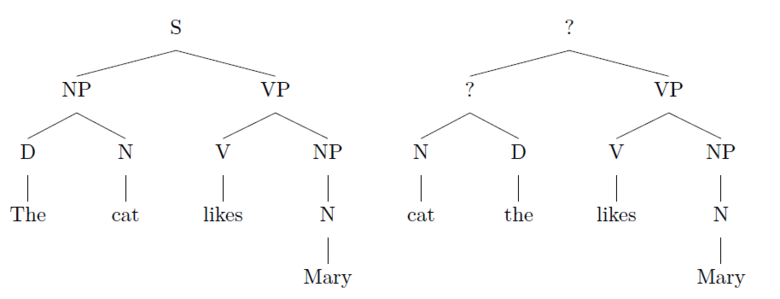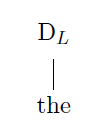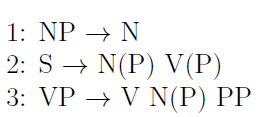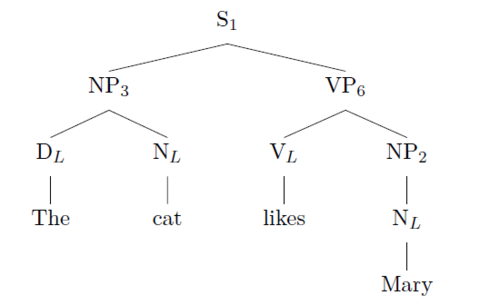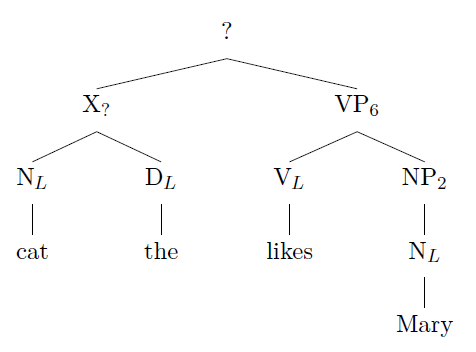Syntax 1 Wiki: Week 1
The English Language and its Grammar
1. For the purposes of Syntactic Theory, a string consists of one or more words:
dogs, Hunde, einkaufen gehen, to go shopping, the student of Linguistics,...
2. For the purposes of English Syntax, we distinguish between two kinds of strings:
- a. Strings which native speakers would accept as English: dogs, to go shopping, loves Jill, waiting for the bus, it is raining, happy cats, …
- b. Strings which native speakers would not accept as English: Hunde,einkaufen gehen, go to shopping, waiting for bus the …
3. It is the task of English syntax to explain in a precise and principled fashion
which strings of words native speakers of English accept as well formed
English and which not.
4. This task would be easy to accomplish, if one could simply list all the
English strings. But, unfortunately, one cannot do that, since there are
infinitely many well formed English strings:
| a. Mary is tired. Mary is very tired. Mary is very, very, very tired., ... |
b. Mary went to the store. Mary went to the store but Jill stayed home. Mary went to the store but Jill stayed home and Sue had the flu., ... |
5. So, it is impossible to list all and only the well formed strings of English
words. But what is possible, is to find a property that all and only the
strings of English have in common: they and only they are grammatical
according to the Grammar of English! All other strings are ungrammatical
according to the Grammar of English.
6. So, we need to concern ourselves with the Grammar of English. This is
what this course is all about!
7. For the purposes of English syntax, the Grammar of English consists
of two parts:
- a. The English Lexicon: a, aardvark, able, abut … …
- b. The English Phrase Structure Rules: S -> NP VP, NP -> D N
8. With the Grammar of English at our disposal, it is now easy to define what it means for a string of words to be grammatical English: a string of words is grammatical English, if the English grammar licenses a well formed phrase structure tree for that string. Otherwise, the string is ungrammatical in English.
Example:
- a. Since the tree on the left is a well formed phrase structure tree of English, its string The cat likes Mary is a grammatical expression of English.
- b. Since the tree on the right is not a well formed phrase structure tree for English, its string *cat the likes Mary is not a grammatical string of English.
9. So, we can define the English Language as all and only those strings
for which the English grammar licenses a well formed phrase structure tree.
Everything else is not part of the English language.
10. We now need to make precise how the grammar of English licenses well
formed phrase structure trees. For that, we need a simple, but important
technical concept, that of a local tree.
A local tree consists of a single mother node and 1-3 daughters:
Nothing else is a local tree.
11. We now say that the grammar of English licenses a phrase structure tree,
if the following two conditions are met:
- the tree is completely composed of local trees and
- the grammar of English licenses every one of those local trees.
For example, the grammatical phrase structure tree in 8. above is composed of eight local trees.
- Four of the local trees have a word at the bottom and for that reason are called Lexical local trees:
- The other four local trees have parts of speech (= syntactic categories) as labels of all nodes and thus are called non-lexical local trees:
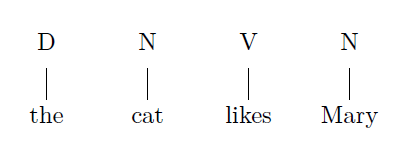

12. It is now easy to see how the grammar of English can license all and only
the local trees that make up all the grammatical phrase structure trees of
English. Recall that the grammar has two parts, the lexicon and the phrase
structure rules. The lexicon will license the lexical local trees of English and
the phrase structure rules will license the non-lexical local trees of English.
13. The English Lexicon revisited
We will now be a little more precise as to what the English lexicon looks like.
Here is the portion of the English lexicon that shows the words that occur in
the word strings of 8. As you can see, each word is now listed with its part
of speech:
cat, N
likes, V
Mary, N
the, D
14. The lexicon licences lexical local trees
It is easy to see that the lexical entries contain exactly the right information
to license the lexical local trees. The general principle is the following:
In “XL”, X is a part of speech and the subscript L means that the local tree is licensed by a lexical entry.
is licensed by the grammar of English, since

is a line in the English lexicon.
Note that the remaining lexical entries in 13. license the remaining three lexical trees in 11.
15. The phrase structure rules license non-lexical local trees
All the phrase structure rules have the following form:
“N” is the individual number of the rule.
Examples:
Each of these rules contains exactly the right information to license one kind
of non-lexical local tree. The general principles are the following:
a.Let X and Y be categories. Then, a local tree of the form

is licensed by the grammar of English, if

is an English phrase structure rule.
- Example:
A local tree of the form

is licensed by the grammar of English, since

is an English phrase structure rule.
b. A local tree of the form

is licensed by the grammar of English, if
is an English phrase structure rule and y licences Y and z licences Z.
x licences X
x(p) licences X and XP.
- Example:
A local tree of the form

is licensed by the grammar of English, since
is an English phrase structure rule.
c. A local tree of the form

is licenced by the grammar of English, if
V: X -> w y z
is a phrase structure rule and w licences W, y licences Y, z licences Z
x licences X
x(p) licences x and XP
- Example:
A local tree of the form

is licenced by the Grammar of English, since
is an English phrase structure rule.
16. Assume that the following are all phrase structure rules (PSRs) of English. Hover over each PSR to see an example:
1: S -> NP VP
2: NP -> N
3: NP -> D N
4: VP -> V
5: VP -> V NP
6: AP -> A
7: AP -> A PP
Then, each of the non-lexical local trees in 11. are licensed by the grammar
of English, since for each of them there is an English phrase structure rule
that licenses it.
17. Summary: We have now proved that the following phrase structure tree
is licensed by the grammar of English, because it is completely composed
of local trees that are either licensed by the English lexicon or the English
phrase structure rules:
And, since the English grammar licenses this tree, its word string The cat
likes Mary is a grammatical expression of English. And the same for every
other one of the infinitely many word strings which native speakers accept
as grammatical English!
18. Contrast this with the word string *cat the likes Mary which native
speakers of English do not regard as part of their language. In order to draw
a phrase structure tree for this string,
we would need a phrase structure rule of the form
that is, a rule that combines the categories N and D in that order to form
a category X. But, English has no such phrase structure rule! Therefore,
the English grammar does not license a phrase structure tree for the string
cat the likes Mary, which explains why speakers of English regard it as
ungrammatical. The same for all the infinitely many strings of words which
are ungrammatical in English!
19.The listing problem is now solved
Remember that it is impossible to list all the grammatical strings or their
phrase structure trees of English, since there are infinitely many. No speaker
is able to memorize them all.
But, it is possible to list the grammar of English, which licenses all and
only the phrase structure trees of the strings of English words: over several
years of language acquisition, children can easily memorize the several ten
thousands of words of English and the 100+ phrase structure rules of the
language.
Task for Week 2
1. Please follow the given example and explain if the sentence The big dog watched the small bird is grammatical according to the Grammar of English. Draw the phrase structure tree for the sentence on a sheet of paper, take a picture of it, and upload it to OLAT (Student Submissions folder).
